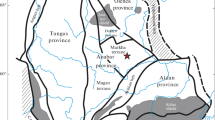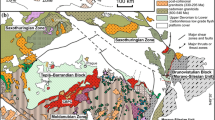Abstract
Garnet-bearing ultramafic rocks (GBU) enclosed in high-grade gneisses are known from several parts of the Bohemian Massif. One of these is the high-pressure(HP)-unit 1 in the Erzgebirge Crystalline Complex, which is the subject of the present study. Hitherto, two different models have been put forward to explain the stabilisation of garnet in mantle-derived ultramafic rocks from the Bohemian Massif and their emplacement into the crust. (1) Garnetiferous assemblages were formed in the ultramafics before they came in contact with their crustal host rocks. (2) Garnet was formed in the ultramafics at the expense of spinel due to cooling caused by their tectonic emplacement in the crust. The PT-evolution revealed by the investigated GBU from the Erzgebirge Crystalline Complex, however, requires a third model. The reconstruction of the PT-paths for the Erzgebirge GBU is based on both conventional thermobarometry and phase relations. Thermodynamic calculations allowed the construction of a PT-phase diagram for the system Na2O-CaO-MgO-Al2O3-SiO2-H2O, which is the first quantitative petrogenetic grid in this model system relevant to ultramafic HP-rocks. The grid shows the uni-, di-, and tri-variant assemblages stable in peridotitic rocks at different PT-conditions, providing a tool to constrain PT-paths from the succession of mineral assemblages observed in a rock. The PT-path obtained for the Erzgebirge GBU suggests that the garnet-bearing assemblages formed by HP-metamorphism of spinel peridotite which was emplaced into the crust prior to or during the HP-compressional stage. This model is supported by peak PT-conditions around 900 °C and 30–35 kbar recorded by the ultramafic rocks, which are very similar to those attained in the eclogites sensu stricto which occur in the same tectonic unit (HP-unit 1) and for which an in situ metamorphism has been inferred (Schmädicke et al. 1992). On the other hand, the other two high-pressure units in the Erzgebirge, HP-units 2 and 3, which also contain eclogites sensu stricto but lack peridotites, record lower peak PT-conditions of 650–750 °C/24–26 kbar and 600–650 °C/20–24 kbar, respectively. Postulating an in situ HP-metamorphism for the garnet peridotites as result of continental collision during the Variscan orogeny, a crustal thickness of 90–110 km would be required. A comparison of the distribution of eclogites sensu stricto and mantle-derived rocks from the Bohemian Massif together with their reported PT-conditions reveals a correlation between peak PT-conditions in eclogites sensu stricto and the prevailing assemblages in the ultramafic rocks in the same unit. Furthermore, the Erzgebirge Crystalline Complex and the Snieznik Complex on one hand as well␣as the Granulitgebirge and the Sowie Góry on the other hand are thought to be genetically linked. The garnet peridotites from the Granulitgebirge, the Sowie Góry and the Gföhl unit seem to have experienced peak PT-conditions not recorded by their country rocks with non-eclogitic basic interlayers, inferring a formation of␣HP-assemblages in the ultramafics prior to their emplacement into the crust.
Similar content being viewed by others
Author information
Authors and Affiliations
Additional information
Received: 21 August 1995 / Accepted: 18 September 1996
Rights and permissions
About this article
Cite this article
Schmädicke, E., Evans, B. Garnet-bearing ultramafic rocks from the Erzgebirge, and their relation to other settings in the Bohemian Massif. Contrib Mineral Petrol 127, 57–74 (1997). https://doi.org/10.1007/s004100050265
Issue Date:
DOI: https://doi.org/10.1007/s004100050265




